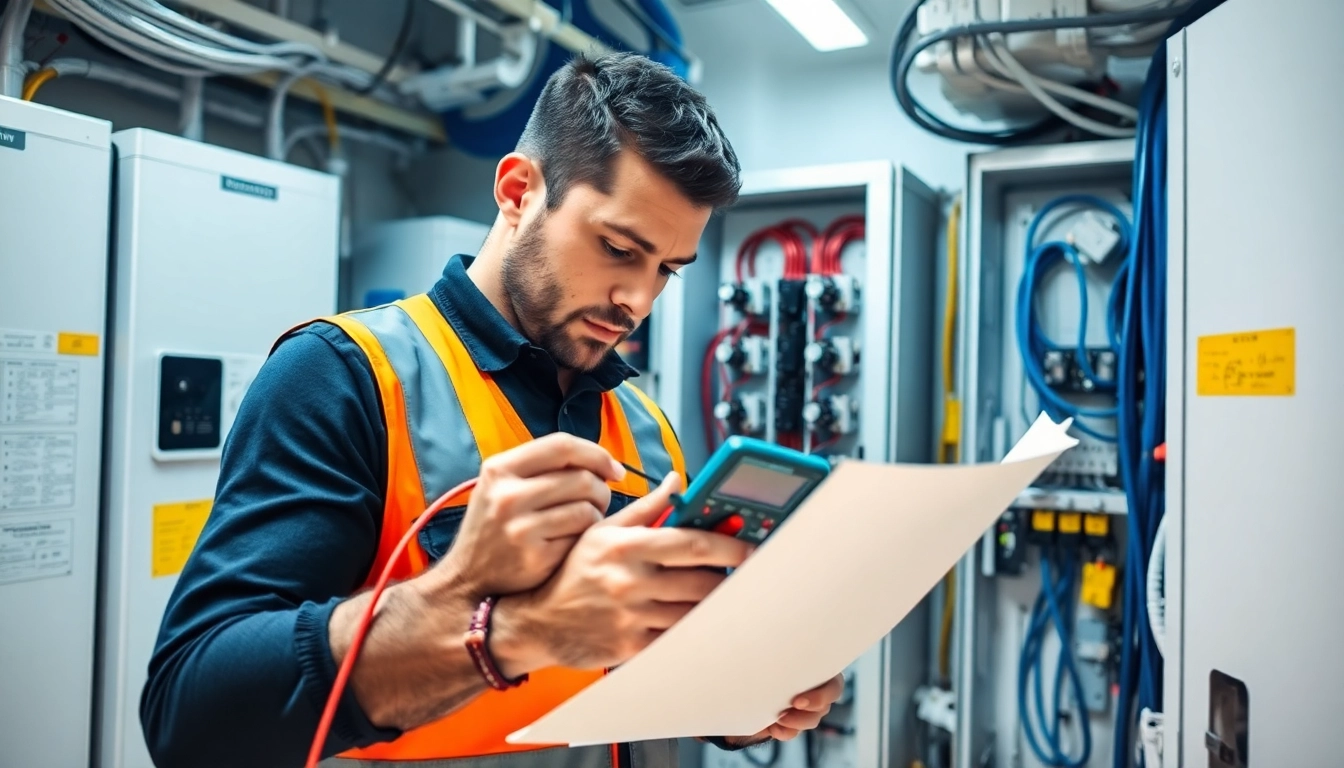1. What Are EICR Inspections?
1.1 Definition and Purpose of EICR Inspections
An Electrical Installation Condition Report (EICR) inspection is a critical evaluation process that ensures the electrical systems in buildings are safe, efficient, and up to code. Essentially, an EICR outlines the overall condition of the electrical installations, identifying any potential hazards, defects, or deviations from established safety standards.
The purpose of an EICR is multifaceted. Primarily, it aims to ensure that the electrical installations are safe for continuous use, which protects both occupants and property from electrical hazards such as fires or electric shocks. Furthermore, the EICR serves as essential documentation for property owners, especially landlords, providing them with a reliable overview of the electrical system’s condition and compliance with legal standards. Conducting EICR Inspections is not just about compliance; it reflects a commitment to electrical safety and responsible property management.
1.2 Key Components Evaluated During Inspections
EICR inspections cover several key components of electrical installations:
- Wiring Condition: Inspectors check for signs of wear, damage, or deterioration in electrical wiring that may pose safety risks.
- Socket Outlets: All socket outlets are tested for proper functioning and safety to ensure they can handle intended loads without issues.
- Professional Installation Standards: The inspection verifies if the installation meets both local and international electrical standards, reflecting professional workmanship.
- Earth Fault Loop Impedance: This evaluation measures the effectiveness of the earthing system, crucial for electrical system safety.
- Residual Current Devices (RCDs): RCDs are checked for functionality to ensure they will disconnect in case of faults, preventing electric shocks.
1.3 Importance of EICR Inspections for Property Safety
The significance of EICR inspections cannot be overstated. They are integral to maintaining the safety of electrical systems in residential, commercial, and industrial properties. Regular inspections help identify and rectify issues before they escalate into severe hazards, ensuring the well-being of occupants and efficiency of electrical systems.
Moreover, EICR inspections are often legally mandated, especially for landlords. Non-compliance can lead to serious repercussions, including legal penalties, property damage, and jeopardized tenant safety. Therefore, prioritizing EICR inspections is not just good practice; it’s a cornerstone of responsible property management.
2. Legal Requirements for EICR Inspections
2.1 Regulations Governing EICR Inspections
The legal framework surrounding EICR inspections varies by region but generally falls under electrical safety regulations mandated by government agencies or local authorities. In many jurisdictions, such as the UK, landlords are legally required to have an EICR conducted at least every five years to ensure their properties meet safety standards. Adhering to these regulations is crucial not only for compliance but also for safeguarding the health and safety of tenants.
2.2 Who Needs EICR Inspections? A Guide for Landlords
Landlords play a significant role in electrical safety, making EICR inspections a necessity. Anyone letting properties—residential or commercial—is required to ensure their electrical installations are safe and compliant. This includes private landlords, property managers, and even commercial businesses. The legal obligations often extend to providing tenants with a copy of the EICR once it is completed and if any remedial work is undertaken, to ensure transparency and safety.
2.3 Consequences of Skipping EICR Inspections
Neglecting EICR inspections can lead to severe consequences. Firstly, there are legal ramifications, including fines and possible imprisonment for landlords failing to comply with local electrical safety regulations. Secondly, the financial implications can be significant due to potential property damage caused by undetected electrical faults. Additionally, home insurance policies may become void if appropriate inspections are not conducted, leaving property owners vulnerable to substantial repair costs.
Ultimately, the price of neglect far outweighs the investment required for regular EICR inspections, making it an essential aspect of property management and safety.
3. The EICR Inspection Process
3.1 Preparing for EICR Inspections: What to Expect
Preparing for an EICR inspection involves several steps to ensure a smooth and comprehensive evaluation. Property owners should ensure that access to all areas of the electrical system is available, including fuse boxes, circuit breakers, and any concealed wiring. It is also advisable to review previous EICR reports, as these provide valuable information on recurring issues that might require special attention.
Additionally, notifying tenants about the impending inspection helps them prepare by ensuring they are home to grant access, if necessary, and that all electronic devices are accounted for during the inspection process.
3.2 Step-by-Step Guide to Conducting EICR Inspections
The process of conducting an EICR can be broken down into distinct phases:
- Visual Inspection: A certified electrician will visually inspect all accessible electrical components, including the condition of wiring, fixtures, and installations.
- Testing: Using specialized equipment, the electrician will conduct tests such as continuity tests, insulation resistance tests, and RCD tests to check functionality.
- Reporting: Following testing, results are compiled into an EICR report. This document outlines the condition of the wiring, any observed deficiencies, and recommendations for remedial action if necessary.
3.3 Interpreting the Results of EICR Reports
Interpreting an EICR report requires understanding the terminology and classification of findings. Results are generally categorized as “satisfactory” or “unsatisfactory.” Satisfactory indicates that the installation is in good condition and complies with current standards, while unsatisfactory points to immediate risks needing urgent attention. The report will also include numbered code references, guiding property owners to the specifics of any faults detected during the inspection.
Deciphering these results can be critical; thus, property owners should consider seeking advice from qualified electricians regarding necessary remedial actions and timelines for repairs.
4. Costs Associated with EICR Inspections
4.1 Breakdown of EICR Inspection Costs
The costs associated with EICR inspections can vary widely depending on several factors, including property size, location, and the complexity of the electrical systems involved. Typically, smaller residential properties might incur inspection costs ranging from $150 to $300, while larger commercial buildings could see costs exceeding $1,000. It is essential for property owners to obtain quotes from multiple certified electricians to ensure they receive fair pricing without compromising on quality.
4.2 Factors Influencing the Price of Inspections
Several variables can affect the cost of EICR inspections, including:
- Property Size: Larger properties or those with more complex electrical systems naturally require more time and expertise to inspect.
- Geographic Location: Urban areas may impose higher labor costs due to demand, while rural areas may face higher travel fees.
- Condition of the Electrical System: Properties with preceding issues or extensive retrofitting may require deeper assessments, thus increasing costs.
4.3 Long-term Financial Benefits of Regular EICR Inspections
While the initial costs of conducting EICR inspections might seem substantial, the long-term savings outweigh these investments significantly. Regular inspections can prevent costly emergency repairs, minimize downtime for businesses, and reduce insurance premiums by demonstrating proactive safety measures. Moreover, maintaining a well-functioning electrical system leads to energy efficiency, further cutting costs related to utilities.
Ultimately, committing to regular EICR inspections is an investment in safety, compliance, and cost-efficiency that pays dividends over time.
5. Best Practices for Electrical Safety and Compliance
5.1 Scheduling EICR Inspections: Frequency and Timing
Determining how often EICR inspections should be conducted hinges on several factors such as the type of property, occupancy level, and electrical usage. As a general rule of thumb:
- Residential Properties: Inspections every five years, or sooner if significant renovations or changes are made.
- Commercial Properties: Inspections should be conducted more frequently, typically every three to five years, depending on the business type and electrical load.
- High-Risk Environments: Locations such as factories or sporting facilities may require annual inspections due to elevated electrical demands.
5.2 Choosing a Qualified Electrician for EICR Inspections
Selecting a qualified electrician is crucial for effective EICR inspections. Property owners should ensure that the electricians they engage are certified and have experience with the EICR process. Checking for licensing, insurance, and favorable reviews can aid in identifying reliable professionals. Additionally, discussing the inspection process beforehand and understanding their approach to identifying potential hazards is vital.
5.3 Keeping Your Electrical Systems Updated and Safe
Maintenance is key to prolonging the lifespan of electrical systems and ensuring safety. Property owners should make it a habit to regularly check their electrical gadgets and installations, ensuring there are no visible damages, outdated circuitry, or obsolete appliances in use. Additionally, following the electricians’ recommendations from the EICR report and investing in modern systems can significantly enhance safety and efficiency.
Furthermore, educating tenants or employees about recognizing signs of electrical issues can foster a culture of safety, enabling proactive reporting of problems before they escalate.



